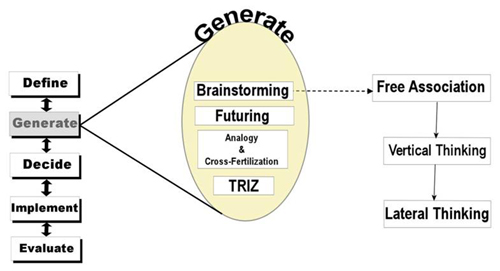
| Brainstorming Scheme | top |
The overall scheme of the brainstorming process is shown below.
We begin with free association. It is followed by vertical thinking using Osborn's checklist,
which reviews and builds on and expands the initial list of ideas.
We then move to lateral thinking using random stimulation and other people's views.
Finally, we engage in futuring, analogy and cross-fertilization, and TRIZ.
Another way to look at the brainstorming process is as follows:

Typically, the initial stages of idea generation begin with an unstructured free association of ideas to solve the problem (brainstorming). During this activity, the group creates lists of all possible solutions. These lists should include wild solutions or unusual solutions without any regard to their feasibility.
| Brainstorming Methods | top |
Brainstorming-one of the oldest techniques to stimulate creativity-is a familiar and effective technique for generating solutions. It provides an excellent means of getting the creative juices flowing.
Brainstorming is one of the most important techniques to generate and develop new ideas. Below are some comments that reduce the effectiveness of brainstorming:

| Free Association | top |
Typically, the initial stages of idea generation begin with an unstructured free association of ideas to solve the problem (brainstorming). During this activity, the group creates lists of all possible solutions. These lists should include wild solutions or unusual solutions without any regard to their feasibility.

| Vertical Thinking: Osborn's Checklist (S.C.A.M.P.E.R.) | top |
Vertical thinking can build on the ideas already generated (piggybacking) or it can look at the different parts of the problem in an effort to generate new ideas. One of the vertical thinking techniques is Osborn's checklist:
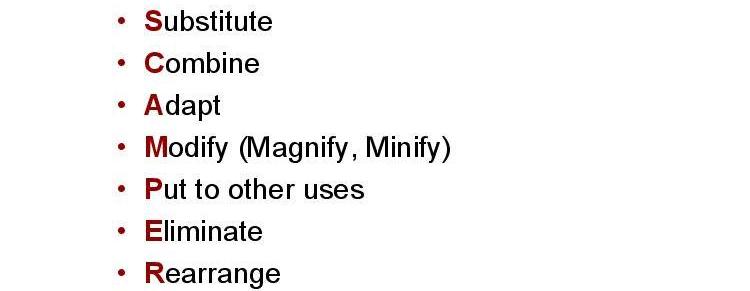
Osborn's Checklist for adding new ideas.
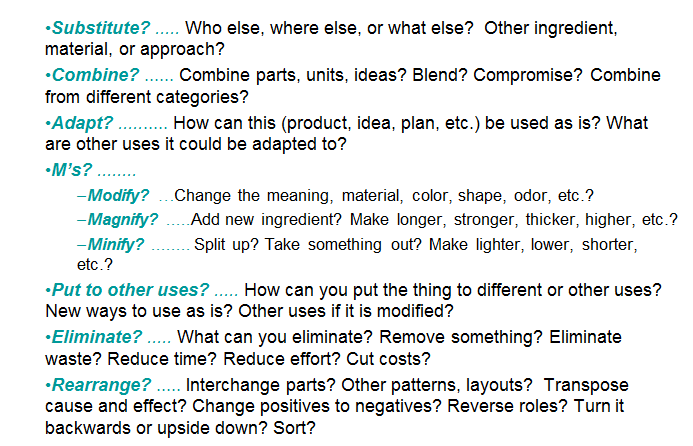
| Lateral Thinking | top |
Edward de Bono developed the lateral thinking techniques of random stimulation and using other people's views to generate ideas during brainstorming. Lateral thinking provides two different ways to come at the problem direction and get "unstuck." It ensures that ideas are generated that never would be generated by free association or vertical thinking.
Lateral thinking helps to generate new ideas when you are stuck in a rut.


| Organizing Brainstorming Ideas: The Fishbone Diagram | top |
Fishbone diagrams are a graphical way to organize and record brainstorming ideas. These diagrams look like a fish skeleton (hence their name). To construct a fishbone diagram, we follow this procedure:

1. Write the real problem you want to solve by generating ideas in a box or a circle to the right of the diagram. Next, draw a horizontal line (the backbone) extending from the left side to the box:

2. Categorize the potential solutions into several major categories (e.g., whole car, parts, painting) and list them along the bottom or top of the diagram. Extend diagonal lines from the major categories to the backbone. These lines form the basic skeleton of the fishbone diagram.
3. Place the potential solutions related to each of the major categories along the appropriate line (or bone) in the diagram.
A fishbone diagram for organizing the ideas for the cars as playground equipment problem is shown below. The most difficult task in constructing such a diagram is deciding which major categories to use for organizing the options. In this example, we have selected "Painting," "Whole Car," and "Parts."
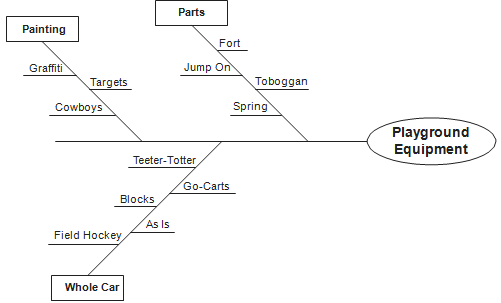
| Brainwriting | top |
In brainwriting, you follow the same procedure as brainstorming (e.g., free association, Osborn's checklist, random stimulation, futuring). Write down your ideas as fast as you generate them, without pausing or stopping to evaluate the ideas. Also, keep a notebook handy to write down ideas whenever they occur to you, because they often come at unusual times. After you have completed your list, organize your ideas (solutions) into a fishbone diagram.

| Futuring | top |
Futuring is a blockbusting technique that focuses on generating solutions that currently may not be technically feasible but might become practical in the future. In futuring, we ask questions such as "What are the characteristics of an ideal solution?" and "What currently existing problem would make our jobs easier when solved, or would solve many subsequent problems, or would make a major difference in the way we do business?"

| Analogy and Cross-Fertilization | top |
Generating ideas by analogy is an approach that works quite well for many individuals. With this strategy, we look for analogous situations and problems in both related and unrelated areas. To use this technique effectively, of course, it is important that you read and learn about things outside your area of expertise.
To practice generating ideas by cross-fertilization, you might ask what each of the following pairs would learn if they went to lunch or dinner together that would improve themselves and/or the way they perform their jobs.
| Incubating Ideas | top |
The incubation period is very important in problem solving. Working on a solution to a problem and being forced to meet a deadline often causes you to pick the first solution that comes to mind and then "run with it," instead of stopping to think about alternative solutions. Many times it is advantageous to take a break when working on a problem to let your ideas incubate while your subconscious works on it. Of course, you shouldn't turn the responsibility over to your subconscious completely by saying, "Well, my subconscious hasn't solved the problem yet."

| Open-Ended Algorithm | top |

| TRIZ | top |
TRIZ, which stands for "Teoriya Resheniya Izobreatatelskikh Zadatch" and is Russian for the Theory of Inventive Problem Solving (TIPS), is the brainchild of Russian engineer and scientist Genrich Altshuller who studied tens of thousands of patents to look for similarities and innovations in the patents. The TRIZ process recognizes that technical systems evolve towards the increase of ideality by overcoming contradictions mostly with minimal introduction of resources.
|
|
"Think TRIZ for Creative Problem Solving" from Quality Digest (2003) by Ellen Domb |
One can think of TRIZ as another way of Lateral Thinking. TRIZ is based on two basic principles as described by Domb.
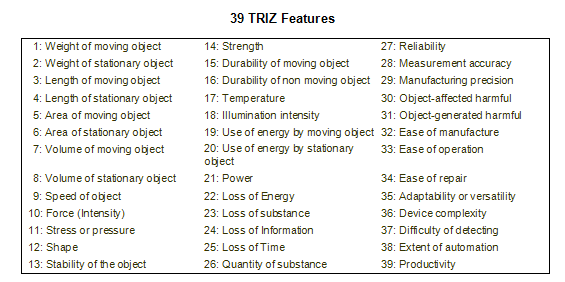
A complete description of each of the features in the table can be found at:
|
|
TRIZ website (http://www.triz-journal.com/archives/1998/11/d/default.asp) |
This list is used to formulate a 39x39 Contradiction Matrix by listing each of the features along the side and top. The features along the top are those that make the product or situation worse (bad) and those along the side improve the product or situation (good).



Explanations of each of the 40 principles are available on TRIZ40 website. We now need a means to determine which of these 40 Principles might be applicable to solving our current problem (e.g. developing a better airplane material).
An interactive form of the TRIZ contradiction matrix is available at:|
|
http://www.triz40.com |
|
|
Example Application of TRIZ - A New Structural Material for Bullet Proof Garment |